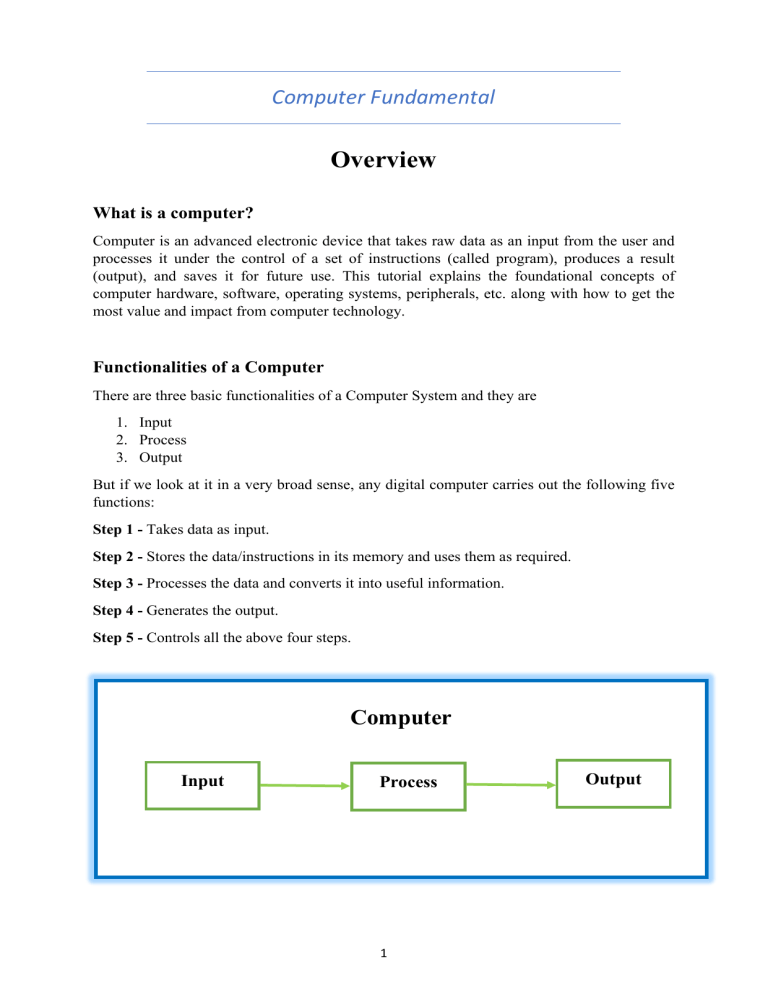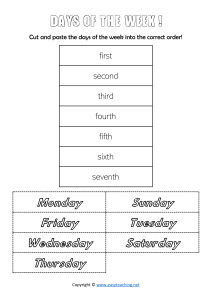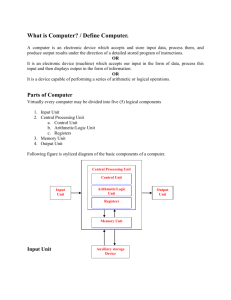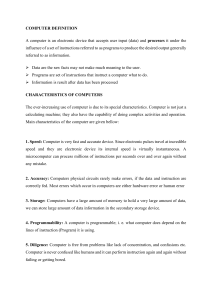
Computer Fundamental Overview What is a computer? Computer is an advanced electronic device that takes raw data as an input from the user and processes it under the control of a set of instructions (called program), produces a result (output), and saves it for future use. This tutorial explains the foundational concepts of computer hardware, software, operating systems, peripherals, etc. along with how to get the most value and impact from computer technology. Functionalities of a Computer There are three basic functionalities of a Computer System and they are 1. Input 2. Process 3. Output But if we look at it in a very broad sense, any digital computer carries out the following five functions: Step 1 - Takes data as input. Step 2 - Stores the data/instructions in its memory and uses them as required. Step 3 - Processes the data and converts it into useful information. Step 4 - Generates the output. Step 5 - Controls all the above four steps. Computer Input Process 1 Output Advantages of Computers Following are certain advantages of computers. High Speed • Computer is a very fast device. • It is capable of performing calculation of very large amount of data. • The computer has units of speed in microsecond, nanosecond, and even the picosecond. • It can perform millions of calculations in a few seconds as compared to man who will spend many months to perform the same task. Accuracy • In addition to being very fast, computers are very accurate. • The calculations are 100% error free. • Computers perform all jobs with 100% accuracy provided that the input is correct. Storage Capability • Memory is a very important characteristic of computers. • A computer has much more storage capacity than human beings. • It can store large amount of data. • It can store any type of data such as images, videos, text, audio, etc. Diligence • Unlike human beings, a computer is free from monotony, tiredness, and lack of concentration. • It can work continuously without any error and boredom. • It can perform repeated tasks with the same speed and accuracy. Versatility • A computer is a very versatile machine. • A computer is very flexible in performing the jobs to be done. • This machine can be used to solve the problems related to various fields. • At one instance, it may be solving a complex scientific problem and the very next moment it may be playing a card game. 2 Reliability • A computer is a reliable machine. • Modern electronic components have long lives. • Computers are designed to make maintenance easy. Automation • Computer is an automatic machine. • Automation is the ability to perform a given task automatically. Once the computer receives a program i.e., the program is stored in the computer memory, then the program and instruction can control the program execution without human interaction. Reduction in Paper Work and Cost • The use of computers for data processing in an organization leads to reduction in paper work and results in speeding up the process. • As data in electronic files can be retrieved as and when required, the problem of maintenance of large number of paper files gets reduced. • Though the initial investment for installing a computer is high, it substantially reduces the cost of each of its transaction. Disadvantages of Computers Following are certain disadvantages of computers. No I.Q. • A computer is a machine that has no intelligence to perform any task. • Each instruction has to be given to the computer. • A computer cannot take any decision on its own. Dependency • It functions as per the user’s instruction, thus it is fully dependent on humans. Environment • The operating environment of the computer should be dust free and suitable. No Feeling • Computers have no feelings or emotions. • It cannot make judgment based on feeling, taste, experience, and knowledge unlike humans. 3 Application of Computers in Various Fields Business A computer has high speed of calculation, diligence, accuracy, reliability, or versatility which has made it an integrated part in all business organizations. Computer is used in business organizations for: • • • • • Payroll Calculations Budgeting Sales Analysis Managing Employee Database Maintenance of stocks, etc. Banking Today, banking is almost totally dependent on computers. Banks provide the following facilities: • • Online accounting facility, which includes checking current balance, making deposits and overdrafts, checking interest charges, shares, and trustee records. ATM machines which are completely automated are making it even easier for customers to deal with banks. Insurance Insurance companies are keeping all records up-to-date with the help of computers. Insurance companies, stock broking firms are widely using computers for their concerns. Insurance companies are maintaining a database of all clients with information showing: • • • • • • • Procedure to continue with policies Starting date of the policies Next due installment of a policy Maturity date Interests due Survival benefits Bonus Education The computer helps in providing a lot of facilities in the education system. • • • • • The computer provides a tool in the education system known as CBE (Computer Based Education). CBE involves control, delivery, and evaluation of learning. Computer education is rapidly increasing the graph of number of computer students. There are a number of methods in which educational institutions can use a computer to educate the students. It is used to prepare a database about performance of a student and analysis is carried out on this basis. 4 Marketing In marketing, uses of the computer are following: • • Advertising - With computers, advertising professionals create art and graphics, write and revise copy, and print and disseminate ads with the goal of selling more products. Home Shopping - Home shopping has been made possible through the use of computerized catalogues that provide access to product information and permit direct entry of orders to be filled by the customers. Healthcare Computers have become an important part in hospitals, labs, and dispensaries. They are being used in hospitals to keep the record of patients and medicines. It is also used in scanning and diagnosing different diseases. ECG, EEG, ultrasounds and CT scans, etc. are also done by computerized machines. Following are some major fields of health care in which computers are used. • • • • • Diagnostic System - Computers are used to collect data and identify the cause of illness. Lab-diagnostic System - All tests can be done and the reports are prepared by computer. Patient Monitoring System - These are used to check the patient's signs for abnormality such as in Cardiac Arrest, ECG, etc. Pharma Information System - Computer is used to check drug labels, expiry dates, harmful side effects, etc. Surgery - Nowadays, computers are also used in performing surgery. Engineering Design Computers are widely used for Engineering purpose. One of the major areas is CAD (Computer Aided Design) that provides creation and modification of images. Some of the fields are: • • • Structural Engineering - Requires stress and strain analysis for design of ships, buildings, budgets, airplanes, etc. Industrial Engineering - Computers deal with design, implementation, and improvement of integrated systems of people, materials, and equipment. Architectural Engineering - Computers help in planning towns, designing buildings, determining a range of buildings on a site using both 2D and 3D drawings. Military Computers are largely used in defence. Modern tanks, missiles, weapons, etc. Military also employs computerized control systems. Some military areas where a computer has been used are: • • • • Missile Control Military Communication Military Operation and Planning Smart Weapons 5 Communication Communication is a way to convey a message, an idea, a picture, or speech that is received and understood clearly and correctly by the person for whom it is meant. Some main areas in this category are: • • • • • • E-mail Chatting Usenet FTP Telnet Video-conferencing Government Computers play an important role in government services. Some major fields in this category are: • • • • • • • Budgets Sales tax department Income tax department Computation of male/female ratio Computerization of voters’ lists Computerization of PAN card Weather forecasting 6 Generations of Computers Generation in computer terminology is a change in technology a computer is/was being used. Initially, the generation term was used to distinguish between varying hardware technologies. Nowadays, generation includes both hardware and software, which together make up an entire computer system. There are five computer generations known till date. Each generation has been discussed in detail along with their time period and characteristics. In the following table, approximate dates against each generation has been mentioned, which are normally accepted. Following are the main five generations of computers. Sl. No. Generation & Description First Generation 1 The period of first generation: 1946-1959. Vacuum tube based. Second Generation 2 The period of second generation: 1959-1965. Transistor based. Third Generation 3 The period of third generation: 1965-1971. Integrated Circuit based. Fourth Generation 4 The period of fourth generation: 1971-1980. VLSI microprocessor based. Fifth Generation 5 The period of fifth generation: 1980-onwards. ULSI microprocessor based. 7 First Generation Computers The period of first generation was from 1946-1959. The computers of first generation used vacuum tubes as the basic components for memory and circuitry for CPU (Central Processing Unit). These tubes, like electric bulbs, produced a lot of heat and the installations used to fuse frequently. Therefore, they were very expensive and only large organizations were able to afford it. In this generation, mainly batch processing operating system was used. Punch cards, paper tape, and magnetic tape was used as input and output devices. The computers in this generation used machine code as the programming language. The main features of the first generation are: • • • • • • • • • • Vacuum tube technology Unreliable Supported machine language only Very costly Generates lot of heat Slow input and output devices Huge size Need of AC Non-portable Consumes lot of electricity Some computers of this generation were: • • • • • ENIAC EDVAC UNIVAC IBM-701 IBM-750 8 Second Generation Computers The period of second generation was from 1959-1965. In this generation, transistors were used that were cheaper, consumed less power, more compact in size, more reliable and faster than the first-generation machines made of vacuum tubes. In this generation, magnetic cores were used as the primary memory and magnetic tape and magnetic disks as secondary storage devices. In this generation, assembly language and high-level programming languages like FORTRAN, COBOL were used. The computers used batch processing and multiprogramming operating system. The main features of second generation are: • • • • • • • • • Use of transistors Reliable in comparison to first generation computers Smaller size as compared to first generation computers Generates less heat as compared to first generation computers Consumed less electricity as compared to first generation computers Faster than first generation computers Still very costly AC required Supported machine and assembly languages Some computers of this generation were: • • • • • IBM 1620 IBM 7094 CDC 1604 CDC 3600 UNIVAC 1108 9 Third Generation Computers The period of third generation was from 1965-1971. The computers of third generation used Integrated Circuits (ICs) in place of transistors. A single IC has many transistors, resistors, and capacitors along with the associated circuitry. The IC was invented by Jack Kilby. This development made computers smaller in size, reliable, and efficient. In this generation remote processing, time-sharing, multi-programming operating system were used. High-level languages (FORTRAN-II TO IV, COBOL, PASCAL PL/1, BASIC, ALGOL-68 etc.) were used during this generation. The main features of third generation are: • • • • • • • • • • IC used More reliable in comparison to previous two generations Smaller size Generated less heat Faster Lesser maintenance Costly AC required Consumed lesser electricity Supported high-level language Some computers of this generation were: • • • • • IBM-360 series Honeywell-6000 series PDP (Personal Data Processor) IBM-370/168 TDC-316 10 Fourth Generation Computers The period of fourth generation was from 1971-1980. Computers of fourth generation used Very Large Scale Integrated (VLSI) circuits. VLSI circuits having about 5000 transistors and other circuit elements with their associated circuits on a single chip made it possible to have microcomputers of fourth generation. Fourth generation computers became more powerful, compact, reliable, and affordable. As a result, it gave rise to Personal Computer (PC) revolution. In this generation, time sharing, real time networks, distributed operating system were used. All the high-level languages like C, C++, DBASE etc., were used in this generation. The main features of fourth generation are: • • • • • • • • • • VLSI technology used Very cheap Portable and reliable Use of PCs Very small size Pipeline processing No AC required Concept of internet was introduced Great developments in the fields of networks Computers became easily available Some computers of this generation were: • • • • • DEC 10 STAR 1000 PDP 11 CRAY-1(Super Computer) CRAY-X-MP(Super Computer) Fifth Generation Computers The period of fifth generation is 1980-till date. In the fifth generation, VLSI technology became ULSI (Ultra Large Scale Integration) technology, resulting in the production of microprocessor chips having ten million electronic components. This generation is based on parallel processing hardware and AI (Artificial Intelligence) software. AI is an emerging branch in computer science, which interprets the means and method of making computers think like human beings. All the high-level languages like C and C++, Java, .Net etc., are used in this generation. 11 The main features of fifth generation are: • • • • • • • ULSI technology Development of true artificial intelligence Development of Natural language processing Advancement in Parallel Processing Advancement in Superconductor technology More user-friendly interfaces with multimedia features Availability of very powerful and compact computers at cheaper rates Some computer types of this generation are: • • • • • Desktop Laptop Notebook Ultrabook Chromebook 12




